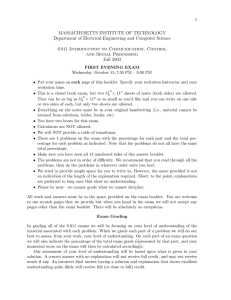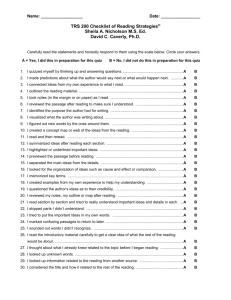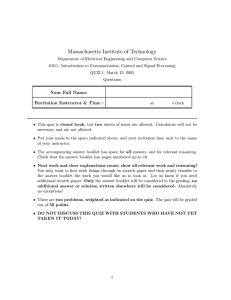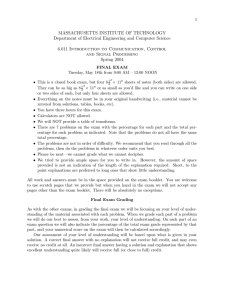MASSACHUSETTS INSTITUTE OF TECHNOLOGY
advertisement
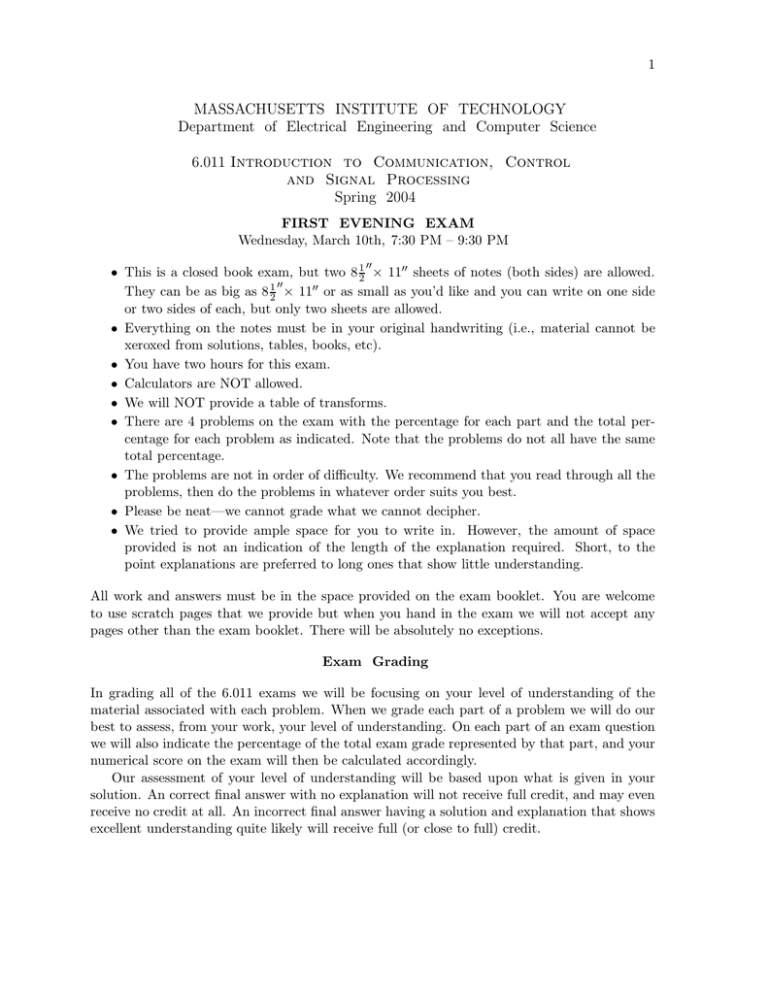
1
MASSACHUSETTS INSTITUTE OF TECHNOLOGY
Department of Electrical Engineering and Computer Science
6.011 Introduction to Communication, Control
and Signal Processing
Spring 2004
FIRST EVENING EXAM
Wednesday, March 10th, 7:30 PM – 9:30 PM
′′
• This is a closed book exam, but two 8 12 × 11′′ sheets of notes (both sides) are allowed.
′′
They can be as big as 8 12 × 11′′ or as small as you’d like and you can write on one side
or two sides of each, but only two sheets are allowed.
• Everything on the notes must be in your original handwriting (i.e., material cannot be
xeroxed from solutions, tables, books, etc).
• You have two hours for this exam.
• Calculators are NOT allowed.
• We will NOT provide a table of transforms.
• There are 4 problems on the exam with the percentage for each part and the total percentage for each problem as indicated. Note that the problems do not all have the same
total percentage.
• The problems are not in order of difficulty. We recommend that you read through all the
problems, then do the problems in whatever order suits you best.
• Please be neat—we cannot grade what we cannot decipher.
• We tried to provide ample space for you to write in. However, the amount of space
provided is not an indication of the length of the explanation required. Short, to the
point explanations are preferred to long ones that show little understanding.
All work and answers must be in the space provided on the exam booklet. You are welcome
to use scratch pages that we provide but when you hand in the exam we will not accept any
pages other than the exam booklet. There will be absolutely no exceptions.
Exam Grading
In grading all of the 6.011 exams we will be focusing on your level of understanding of the
material associated with each problem. When we grade each part of a problem we will do our
best to assess, from your work, your level of understanding. On each part of an exam question
we will also indicate the percentage of the total exam grade represented by that part, and your
numerical score on the exam will then be calculated accordingly.
Our assessment of your level of understanding will be based upon what is given in your
solution. An correct final answer with no explanation will not receive full credit, and may even
receive no credit at all. An incorrect final answer having a solution and explanation that shows
excellent understanding quite likely will receive full (or close to full) credit.
2
This page is intentionally left blank. Use it as scratch paper.
No work on this page will be evaluated.
3
MASSACHUSETTS INSTITUTE OF TECHNOLOGY
Department of Electrical Engineering and Computer Science
6.011 Introduction to Communication, Control
and Signal Processing
Spring 2004
FIRST EVENING EXAM
Wednesday, March 10 , 2004
Full Name:
Points
1(a)
1(b)
1(c)
1(d)
2
3(a)
3(b)
3(c)
3(d)
3(e)
4(a)
4(b)
4(c)
Total
Grader
4
Full Name:
Problem 1 (29%)
x(t) is a WSS random process with autocorrelation function Rxx (τ ) given by:
Rxx (τ ) =
sin(πτ )
πτ
Consider the random processes y(t) defined in terms of x(t) as:
y(t) = x(t) · cos(2π · 103 t)
(a) (5%) Specify whether or not y(t) is WSS. Clearly justify your answer in one sentence.
IT IS WSS
IT IS NOT WSS
Explanation:
(b) (8%) y(t) is processed with a C/D converter as indicated in Figure 1-1.
y(t)
�
C/D
� w[n] = y(nT )
�
T
Figure 1-1:
If possible, determine a non-zero value for T so that the discrete-time sequence w[n] in
Fig.1-1 is wide-sense stationary. If no such value exists clearly explain why not.
NOT POSSIBLE
Work to be looked at:
POSSIBLE
T =
5
Full Name:
(c) (8%) If possible, determine a value of T so that w[n] is wide-sense stationary and is white,
i.e. its PSD Sww (ejΩ ) is a non-zero constant for all Ω. If no such value exists clearly explain why not.
NOT POSSIBLE
POSSIBLE
T =
Work to be looked at:
(d) (8%) Determine E{w2 [n]} in terms of T , i.e. do not assume a specific value of T .
E{w2 [n]} =
Work to be looked at:
6
Full Name:
Problem 2 (10%)
x(t) and y(t) are two WSS random processes. The autocorrelation function of x(t) is Rxx (τ ) = e−|τ | .
State whether or not it is possible to specify a choice for y(t) so that the cross-power-spectral
density Sxy (jω) is as shown in Figure 2-1
Sxy (jω)
2
��
� �
�
�
�
1�
�
�
�
�
�
�
−2
2
�
�−1
�
�
1
�
�
�
�
� �
� �
��
��
ω
−1
Figure 2-1:
If your answer is no, explain why not and state whether it would be possible with a different choice for Sxy (jω). If your answer is yes, explain how you might specify or construct y(t).
YES
Explanation and Reasoning:
NO
7
Full Name:
This page is intentionally left blank. Use it as scratch paper.
No work on this page will be evaluated.
8
Full Name:
Problem 3 (31%)
Consider a communication system for which the channel gain g[n] is time-varying, see Figure 3-1:
g[n]
x[n]
�
� ×
�
� y[n] = g[n] · x[n]
Figure 3-1:
• The transmitted signal x[n] is a wide-sense stationary, zero mean random process.
• The channel gain g[n] is an i.i.d. process with mean µg and variance σg2 .
• x[n] and g[n] are statistically independent.
(a) (5%) Determine E {y[n]}
E{y[n]} =
Work to be looked at:
Full Name:
(b) (10%) Determine Ryy [m] and Rxy [m] in terms of Rxx [m], µg , and σg2 .
Ryy [m] =
Rxy [m] =
Work to be looked at:
9
10
Full Name:
For parts (c), (d) and (e) we would like to process y[n] with an LTI-filter to compensate
for the random channel gain as indicated in Figure 3-2.
� H(z)
y[n]
� r[n]
Figure 3-2:
where H(z) is chosen so that r[n] is a reasonable estimate of x[n].
(c) (4%) If µg = 0 can H(z) be designed so that r[n] is a reasonable estimate of x[n]? Explain
your answer in one or two sentences.
YES
NO
Reasoning:
(d) (4%) If µg is non-zero and σg2 → 0 can H(z) be designed so that r[n] is a reasonable
estimate of x[n]? Explain your answer in one or two sentences.
YES
Reasoning:
NO
11
Full Name:
(e) (8%)As we will see later in the semester an optimal (in some sense) choice for H(z) is:
Hopt (z) =
Sxy (z)
Syy (z)
(i) Determine Hopt (z) in terms of µg , σg2 and Sxx (z).
Hopt (z) =
Work to be looked at:
(ii) Sketch the magnitude of Hopt (ejΩ ) for the special case µg = 10, σg2 = 1 and
jΩ
Sxx (e ) =
�
4, |Ω| < π/4
0, else
as a function of frequency in the graph below. Describe in one or two sentences why
this filter is reasonable.
|Hopt (ejΩ )|
−π
Explanation:
π
Ω
12
Full Name:
Problem 4 (30%)
Consider a discrete-time system represented by the state-space equations below:
q[n + 1] = Aq[n] + bx[n]
y[n] = cT q[n]
� 3
�
� �
�
�
1
2
1
2
with A =
,b=
, and c =
. It is also given that q[n] = 0 for n ≤ −1 and
1 0
2
−1
x[n] = δ[n + 1].
(a) (8%) Determine the eigenvalues λ1 , λ2 and the corresponding eigenvectors v1 , v2 of the
system .
λ1 =
, v1 =
Work to be looked at:
, λ2 =
, v2 =
Full Name:
(b) (10%) Determine q[n] for n ≥ 0
q[n] =
Work to be looked at:
13
14
Full Name:
(c) (12%) We want to express the system in terms of the new set of state variables:
�
�
f1 [n]
f [n] =
= Wq[n]
f2 [n]
In other words, we want to describe the system using the equations:
˜
˜ [n] + bx[n]
f [n + 1] = Af
y[n] = ˜
cT f [n]
State whether or not it is possible to find a transformation matrix W such that ˜
c=
�
�
˜ = 0 . If yes give one possible choice for the transformation matrix W?
and b
1
NOT POSSIBLE
W=
Work to be looked at:
POSSIBLE
�
�
1
,
0
